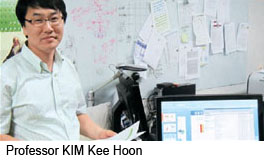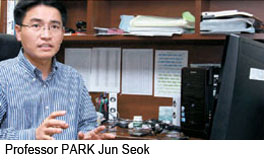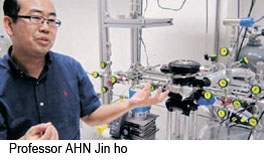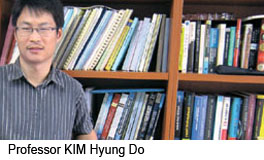Have you ever visited SNU campus late at night? SNU research labs always stay illuminated far into the night.
On Sunday night, SNU English editors made their way through heavy rain to make a surprise visit to SNU campus. The lights from the research laboratories of Building 27 glared through the incessant rain. The research facilities for the College of Natural Sciences are amassed in this building. It was the same scene at the highest point of SNU’s Gwanak campus as the lights were emanating from the windows of the Engineering Research Laboratories in Buildings 301 and 302.
We cautiously opened a door and quietly slipped into a room, trying not to disturb the intensely heated academic debate between a professor and his post-doctoral students. We asked four professors who were still working late at night, what drove them to conduct research until the wee hours of the morning. Their answers were all in sync. They all said that “researching is truly enjoyable!” We asked each of the professors to expand on their answer.
 Professor KIM Kee Hoon from the Department of Physics and Astronomy is currently working on research to discover new materials for next-generation memory devices. He tells us that “I have to fight the strong temptation to go home early to see my beautiful little girls when I head to the research lab every evening.” During the semester, Professor Kim has meetings throughout the day, and during the holidays he is required to give lectures three times a week for summer school courses. We asked him if he doesn’t get exhausted. He replies, “There is no room for exhaustion if you spend every night taking on intellectual challenges.” Professor Kim also emphasized that “support for the field of physics in Korea is only one-tenth of that in Japan. Yet the sheer passion of Korean scientists helps them overcome the financial difference.”
Professor KIM Kee Hoon from the Department of Physics and Astronomy is currently working on research to discover new materials for next-generation memory devices. He tells us that “I have to fight the strong temptation to go home early to see my beautiful little girls when I head to the research lab every evening.” During the semester, Professor Kim has meetings throughout the day, and during the holidays he is required to give lectures three times a week for summer school courses. We asked him if he doesn’t get exhausted. He replies, “There is no room for exhaustion if you spend every night taking on intellectual challenges.” Professor Kim also emphasized that “support for the field of physics in Korea is only one-tenth of that in Japan. Yet the sheer passion of Korean scientists helps them overcome the financial difference.”
 We also had to disturb Professor PARK Jun Seok of the School of Law while he was reading a law journal, asking him what made him stay in his office so late into the night. He smiled as he told us “I have heard that it gets uncomfortable to read when you reach your 50s because your eyesight starts failing. Thus, there is a huge impetus to develop myself when I am still relatively young!” Professor Park had to face a pay cut when he left the courtroom and hung up his robes to become an SNU professor. However, he can tell us with confidence that “I am happy now, because I can focus all of my attention on my research in the field of intellectual property rights, which I have always been particularly fond of.”
We also had to disturb Professor PARK Jun Seok of the School of Law while he was reading a law journal, asking him what made him stay in his office so late into the night. He smiled as he told us “I have heard that it gets uncomfortable to read when you reach your 50s because your eyesight starts failing. Thus, there is a huge impetus to develop myself when I am still relatively young!” Professor Park had to face a pay cut when he left the courtroom and hung up his robes to become an SNU professor. However, he can tell us with confidence that “I am happy now, because I can focus all of my attention on my research in the field of intellectual property rights, which I have always been particularly fond of.”
 We visited Professor AHN Jin ho of the School of Earth and Environmental Sciences around 1 am, when he was still in his office reading an academic journal. Since becoming an SNU professor last year, he has moved into the faculty apartment complex on campus in order to avoid wasting time commuting. Adjacent to his office was an experiment room, where a variety of experiment devices were placed. Amazingly, Professor Ahn designed the experiment room himself for the purpose of researching glaciers. There are only two professors in Korea who study glaciers, including Professor Ahn. The professor said that “I have no option but to work hard as the progress of my research directly determines the level of Korea’s glacier research.”
We visited Professor AHN Jin ho of the School of Earth and Environmental Sciences around 1 am, when he was still in his office reading an academic journal. Since becoming an SNU professor last year, he has moved into the faculty apartment complex on campus in order to avoid wasting time commuting. Adjacent to his office was an experiment room, where a variety of experiment devices were placed. Amazingly, Professor Ahn designed the experiment room himself for the purpose of researching glaciers. There are only two professors in Korea who study glaciers, including Professor Ahn. The professor said that “I have no option but to work hard as the progress of my research directly determines the level of Korea’s glacier research.”
 We also had the opportunity to interview Professor KIM Hyung Do from the Department of Physics and Astronomywho studies the laws of physics at a micro-level. We asked him why he carried on doing research throughout the night. He replied that “It is the joy of knowing that I am researching something that has been unknown to man until now.” The delight of pioneering a new field will be similar to the thrill and excitement Neil Armstrong must have felt when he took his first steps on the moon. The start of the holidays is significant for the professor as “It means that I am allowed to spend all my time and energy on my research. Although it is important to write many academic journal articles, quality should never give way to quantity.”
We also had the opportunity to interview Professor KIM Hyung Do from the Department of Physics and Astronomywho studies the laws of physics at a micro-level. We asked him why he carried on doing research throughout the night. He replied that “It is the joy of knowing that I am researching something that has been unknown to man until now.” The delight of pioneering a new field will be similar to the thrill and excitement Neil Armstrong must have felt when he took his first steps on the moon. The start of the holidays is significant for the professor as “It means that I am allowed to spend all my time and energy on my research. Although it is important to write many academic journal articles, quality should never give way to quantity.”
These professors pointed out the heavy administrative workload, the burden of lecturing classes and the lack of support funds as the biggest obstacles to their research. Statistically, the average research fund per professor during the year 2009 was 220 million KRW, only half of what Harvard University professors receive. The research results, however, have been magnificent. Even when SNU professors taught an average of 8.4 hours a week, they managed to publish 4475 SCI quoted articles. In terms of the number of journal articles published, SNU ranked 20th in the world, ahead of MIT which was ranked 27th.
Written by YU Minseok, SNU English Editor, brits@snu.ac.kr
?
Reviewed by Eli Park Sorensen, SNU Professor of Liberal Studies
Proofread by Brett Johnson, SNU English Editor

